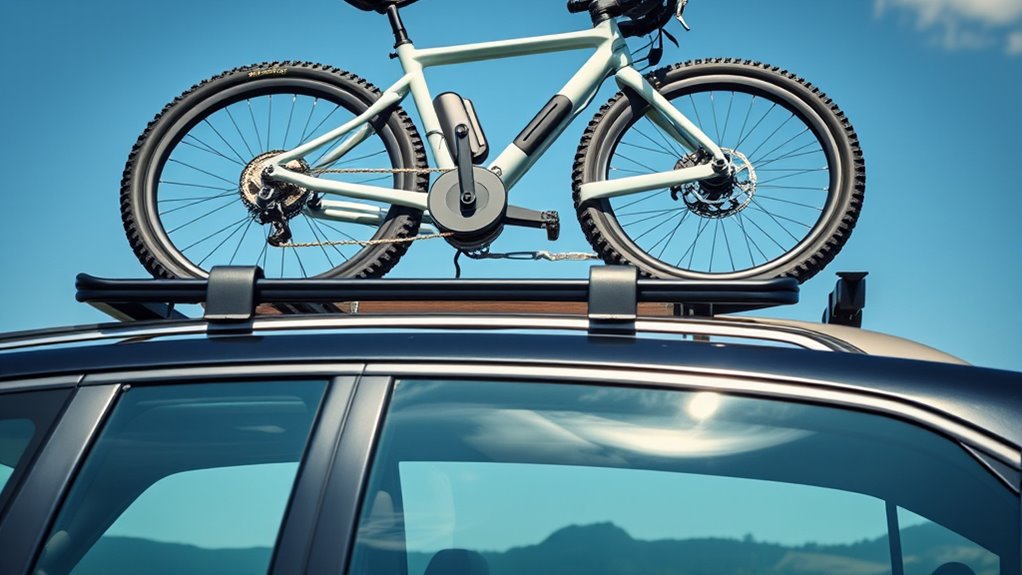To safely transport your e-bike by car, choose a sturdy rack designed for e-bikes, like hitch-mounted or roof-mounted options. Follow the manufacturer’s instructions to secure the rack tightly, then use high-quality straps to anchoring your bike’s frame and wheels firmly. Double-check straps and stability before starting your trip, and regularly inspect during transit to make sure everything stays secure. Want to learn more tips for a smooth, safe journey? Keep going for detailed guidance.
Key Takeaways
- Select a sturdy, compatible hitch- or roof-mounted rack designed for e-bike weight and size.
- Follow manufacturer instructions carefully to securely attach the rack to your vehicle.
- Use high-quality straps to firmly secure the e-bike’s frame or wheels, avoiding damage-prone areas.
- Check bike stability and tighten straps after hitting bumps or during long trips.
- Regularly inspect the entire setup to ensure all components remain tight and secure throughout transit.

Transporting your e-bike by car can be straightforward if you follow the right safety steps. The first essential step is selecting the right bike rack. Not all racks are created equal, so you need to choose one designed specifically for e-bikes or at least capable of handling their weight and size. Look for a rack with a sturdy frame, adjustable arms, and a secure locking system. Consider whether you want a hitch-mounted rack, which tends to be more stable and easier to load, or a roof-mounted rack if you have limited rear clearance. Make sure the rack is compatible with your vehicle and can support the weight of your e-bike safely. Once you’ve settled on the right rack, attaching it securely to your car is essential. Follow the manufacturer’s instructions carefully, ensuring all bolts and clamps are tight and the rack is stable before placing your bike on it.
Once your bike is mounted, focus on securement techniques to prevent any mishaps during transit. You want your e-bike to stay firmly in place, so double-check all straps, clamps, and locks. Use high-quality, ratchet-style straps to anchor the bike’s frame or wheels to the rack. For added security, wrap straps around sturdy parts of the bike and avoid areas that could be damaged or cause instability. Make sure the bike is centered and balanced on the rack to prevent sway or tilting in transit. When securing the wheels, use wheel straps or fork mounts, ensuring they’re tight enough to prevent movement but not so tight that they damage the rims or suspension. Additionally, it’s important to be aware of symptoms of damage or instability that could indicate your bike isn’t properly secured.
Before hitting the road, give your bike a gentle shake to test its stability. If it moves excessively, tighten the straps or reposition the bike until it feels solid. Also, check that the bike’s handlebars and pedals aren’t swinging freely. If they are, stabilize them with additional straps or padding. Keep in mind that the more secure your bike is, the less likely it is to get damaged or cause accidents on the road. Regularly inspect your setup during long trips, especially after hitting bumps or rough patches, to make sure everything remains tight and secure. Proper bike rack selection combined with effective securement techniques will give you peace of mind, letting you focus on enjoying your ride instead of worrying about your e-bike flying off the car.
Frequently Asked Questions
Can I Transport My E-Bike Without Removing the Battery?
You can transport your e-bike without removing the battery, but it’s safer to do so. Removing the battery helps prevent damage and leaks. If you choose to keep it in, make sure to disconnect it properly. Use secure straps to anchor your bike firmly in your car, preventing movement during transit. Always follow your e-bike manufacturer’s guidelines for transportation and safety to avoid damaging your bike or risking accidents.
What Precautions Should I Take During Long-Distance Travel?
During long-distance travel, you should prioritize bike security by securely fastening your e-bike to prevent movement or damage. Use appropriate straps and a sturdy rack, and consider locking mechanisms for added safety. Additionally, check your travel insurance to guarantee your e-bike is covered against theft or accidents. Take these precautions to protect your investment, avoid mishaps, and ensure a smooth journey for your e-bike.
Is It Necessary to Use a Special Rack for E-Bikes?
Using a special rack for your e-bike isn’t always necessary, but it’s highly recommended for bike security and rack compatibility. These racks are designed to handle the weight and frame of e-bikes, ensuring stability during transport. They also minimize damage to your bike and vehicle. Investing in a compatible, high-quality rack makes your long-distance travel safer and more convenient, giving you peace of mind that your e-bike is securely transported.
How Do Weather Conditions Affect E-Bike Transportation Safety?
Weather hazards and road conditions directly impact your e-bike transportation safety. Rain can cause slippery surfaces, reducing traction and increasing the risk of accidents, while snow and ice can make roads treacherous and damage your bike. High winds may destabilize your load, and extreme heat can impact your e-bike’s battery. Always check weather forecasts, secure your e-bike properly, and adjust your driving to guarantee safe transport in changing weather conditions.
Are There Legal Restrictions for Transporting E-Bikes in Vehicles?
You need to be aware of electric scooter regulations and bike carrier laws when transporting your e-bike. Many regions have specific rules about securing your bike properly in a vehicle, including weight limits and approved carriers. Check local laws before you hit the road to avoid fines or penalties. Ensuring compliance with these legal restrictions keeps your e-bike safe during transport and helps you avoid unnecessary trouble.
Conclusion
Transporting your e-bike safely by car keeps both your bike and other drivers protected. Remember, securing your e-bike properly reduces damage and ensures a smooth journey. Did you know that over 60% of bike-related accidents involve improper transportation? By following these tips, you’re not only safeguarding your investment but also contributing to safer roads. So, take the time to secure your e-bike correctly—your safety and peace of mind are worth it.









